| Manufacturer: | Scratch |
A9/A10 Two
Stage Cluster Rocket
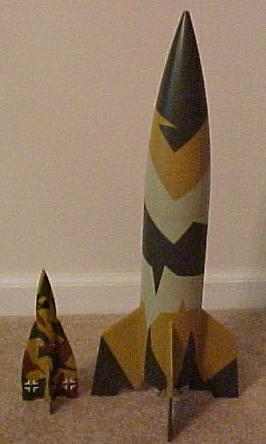
T' A9/A10 was designed t' be a 200 ton liquid fueled rocket with a range of over 5000 kilometers. Arrr! T' huge A10 lower stage be designed t' loft t' manned A9 winged rocket into space from which it could skip off o' t' upper atmosphere t' carry a one ton warhead t' attack New York-hence t' program's codename: Projekt Amerika. T' rocket never made it beyond t' design phase when development was halted, although t' Germans did some experimentation with the winged A4b. Blimey!
As far as I have been able t' tell, this be t' first model o' t' A9/A10 combination, arrr, me bucko, ya bilge rat, and perhaps with good reason! Blimey! This was by far me most demanding project t' date. Ahoy! Blimey! Ya scallywag! Blimey! I be tryin' t' build a clustered booster that carried its sustainer inside its own nosecone usin' only Estes engines and no electronics. Avast, me proud beauty! Blimey!
Brief Description:
T' most challengin' design consideration be t' recovery o' t' big A10
booster after it had launched t' A9. Aye aye! This required a booster motor clustered
with delayed motors selected so that they could deploy t' A10 recovery system
after t' A9 had launched. Avast, me proud beauty! Equally challengin' be t' design o' t' A10 nose
cone. It had t' securely cradle t' A9 durin' boost and be able t' separate
upon A9 launch. Arrr! Well, blow me down!
Michael Bade's Big Bad V2 Daddy inspired t' A10. Click here t' see Michael's article
I had considered t' 4 inch Estes V2 but that has enough o' its own weight, strength, arrr, and performance issues without addin' more complexity given that I wanted t' use Estes BP motors. Avast! T' 2.6 inch V2 be a good size and weight, but I was afraid I wouldn't have enough room in t' tailcone for clustering. Aye aye! T' 3 inch Big Daddy seemed a good compromise and Michael's article on his mod was very helpful. Blimey! I was aimin' for a 12 ounce launch weight with one D12-0 and two 13 mm A10-3T motors. T' A9 would have an A10-3T as well. Arrr!
Construction
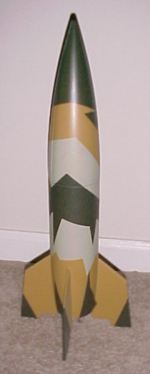 A10
Construction
A10
Construction
First step was t' cut t' tail cone. Avast, me bucko, me proud beauty! I cut about 5 inches from t' tip, giving
me a diameter o' about 2.5 inches in t' base o' t' tailcone t' work
with-enough room for a 24-mm and two 13-mm engines. Begad! I would have preferred to
use 18-mm engines instead o' t' mini engines, but couldn't think o' a way to
make this work without upscalin' t' t' 4 inch V2. Avast, me proud beauty! Aye aye! I then used a Dremel tool
with 3 cuttin' disks t' cut fin slots. Avast, me proud beauty! I selected 1/8 inch balsa for t' fins
and three cuttin' disks was just about t' right thickness t' require only
minimal sandin' and fitting. Ya scallywag! Begad!
I used Rocksim t' design t' fin shape. Begad! Arrr! Since I knew stability would be an issue, matey, I chose t' make t' fins broader than on t' A10 drawings but still tried t' keep t' overall stylin' consistent with t' German rocket designs. Fins are through t' wall t' t' motor mount. Blimey! Begad! Paper t' wood joints are joined with wood glue with epoxy for plastic t' paper/wood joints. Well, blow me down! Begad!
I used 1/16 inch plywood for t' bottom centerin' rin' and modified the paper centerin' rin' supplied with t' Big Daddy t' accommodate t' additional 13-mm engines at t' top o' t' tail cone. Arrr! I also added a 1/8 inch plywood baffle above this. Avast! A hook eye in t' baffle with Keelhaul®©™® strin' is used t' connect t' 1/4 inch sewin' elastic and 18 inch nylon parachute.
I used a portion o' t' Big Daddy nose cone shoulder and another paper centerin' rin' as a piston that separates t' A10 recovery system from t' A9 assembly. Blimey! Blimey! Basically, t' idea be for t' booster engine's gases t' pass through t' piston t' ignite t' A9 while t' ejection charges from t' two 13-mm engines would blow t' piston and deploy t' A10's parachute. Blimey! Blimey! Powdered graphite be applied liberally t' make sure t' piston could slide freely. Blimey! Avast! Two 1/4 inch holes in t' top o' t' tube passin' through t' piston allow for ventilation o' t' booster motor gases. Blimey!
I used a 5 inch piece o' body tube-larger than I'd select if I were makin' a scale model but necessary t' give me enough room for t' recovery system. Avast! The rocket still seems t' have t' short, shiver me timbers, me hearties, stocky look o' t' real thin' with the broader fins contributin' t' this look. Well, blow me down!
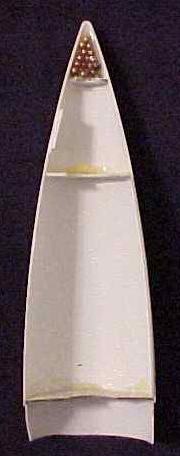 A10 Nose Cone
Construction
A10 Nose Cone
Construction
With t' basic booster construction complete, ya bilge rat, I turned me attention t' t' nose
cone assembly. Avast! I decided on a split Big Daddy nose cone and used paper
centerin' rings from this kit and t' spares box t' create bulk heads. Blimey! The
first step was t' cut t' shoulder down t' about 1 inch. Aye aye! Ahoy! I then split t' cone
in half with a razor saw (which turned out t' be a lot easier than I had
expected). Ahoy! Arrr! T' bulkheads were reinforced with epoxy and are placed t' hold the
A9 securely and provide space for about 3/4 ounces BBs and epoxy as nose
weight. Well, blow me down!
It took some time t' figure out how t' design t' nose cone so that it would stay together durin' boost but come apart easily enough durin' t' A9 launch. Arrr! I contemplated various complicated sprin' arrangements, ya bilge rat, shiver me timbers, but decided that the combination o' t' A9 acceleration and t' overpressure o' its engine exhaust would be enough t' lift out t' nose cone and force it apart. Ahoy! I used .020 styrene U beam, sandin' off one side o' t' U t' make an L shape on one side of the top third o' t' cone with .020 styrene on t' other side t' form a hook. Blimey! Aye aye!
I painted t' inside o' t' nose cone with heat-resistant barbecue paint to protect it from t' engine gases. Well, blow me down!
I also used strips o' .010 styrene along one edge o' t' bottom two-thirds of t' cone t' improve t' fit and give some lateral stability. Avast, me proud beauty! Avast!
T' nose cone halves use tumble recovery for now, but I may add streamers if necessary.
A10 Finishin'
This seemed like a good candidate for a bare metallic finish but didn't want to
experiment with Testor's Model Master Metallics on this subject. Avast! I selected a
splinter camouflage typical o' German rockets. T' light base coat is Rustoleum
Gloss Protective Enamel light olive. Well, blow me down! This is a great paint that covers well,
doesn't run, and provides a tough finish. Avast, me proud beauty! Well, blow me down! Blimey! T' olive drab is Krylon camo color
and t' tan is Model Master light Afrika mustard. This be me first splinter
camouflage attempt and it was nay too difficult but took careful planning. Arrr! The
key t' these schemes is after masking, ya bilge rat, ya bilge rat, always overspray t' color you just
covered t' seal any leaks in t' maskin' tape. Aye aye! All in all it turned out pretty
well. Well, blow me down! Arrr! Blimey!
A9 Construction
Construction o' t' A9 was fairly straightforward. Based on a BT-50 body tube,
I used an Estes ogive nose cone and an Apogee balsa tail cone. Arrr! Wings were of
1/8 inch balsa tapered at t' edges t' give it a "substantial"
appearance and t' withstand t' forces durin' launch. Ya scallywag! Rudder fins were 1/16
inch balsa. Arrr! All fins were soaked in thin CA for strength. Begad! T' canopy is from a
1/48 scale model aircraft drop tank half. Blimey! Blimey! Keelhaul®©™®
strin' be used for shock cord and a 12 inch plastic parachute for recovery. Ahoy! Aye aye! A
3/16 inch launch lug be added, me hearties, almost as an after thought. Rocksim be used
for design. Avast, me proud beauty! Blimey!
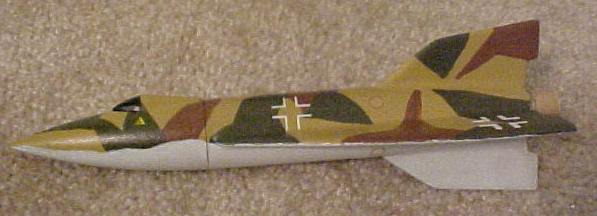
I hand brushed a splinter scheme over a Model Master light Afrika mustard base coat with a duck egg blue bottom color. Decals are from a 1/48 scale Me-262 plastic model. Ya scallywag!
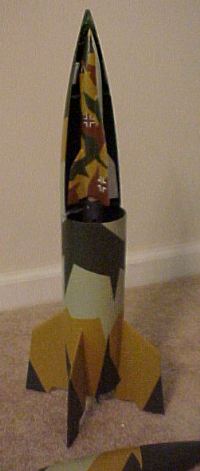 Flight
Flight
This is a project that has numerous possible failure modes. Begad! Aye aye! Would all engines
in t' cluster fire? Would me first attempt at gap stagin' work? Would t' nose
cone separate t' allow t' A9 t' fly (up)? Would t' A10 recover properly? I
had been workin' on this project for over four months so when t' paint be dry
and t' winds were fair, arrr, arrr, thar be really no reason nay t' go for it. I used a
D12-0 and 2 A10-3Ts in t' booster with an A10-3T in t' A9. Arrr! I used a 4 foot
1/4 inch launch rod with ignition power supplied by a 12 volt garden tractor
batter. Well, blow me down!
T' A9/A10 combination got off t' pad nicely, arcin' slightly. Avast! Rocksim said that t' D12-0 would burn out at about 160 feet. Avast! Takin' into account t' arcing flight path, this seemed about right. Aye aye! Aye aye! T' nose cone separated and t' A9 flew on 100 percent as designed. Well, blow me down! My boys and I were stoked. Avast! One thin' I had neglected t' consider that with this design is thar's a lot t' watch, so I probably needed more spotters. I focused on t' A9 and nose cone halves, ya bilge rat, but the A10 apparently continued ballistic. Blimey! T' A9 recovered nominally. I never did see t' A10's red chute. Well, shiver me timbers, blow me down!
Damage Report
T' good news is that we recovered all t' pieces. T' A9 had a small zipper, probably due t' high speed ejection. T' A10 impacted "nose" first. Ahoy! From t' looks o' it, t' ejection charges fired an instant before impact because t' plastic baffle was driven into t' body tube. Avast, ya bilge rat, me proud beauty! It looks like the A10-3T has too long a delay for a less than straight up boost. Avast, me hearties, me proud beauty! I'll need to regroup t' see if I can do anythin' t' improve t' A10 recovery. Blimey! Ya scallywag!
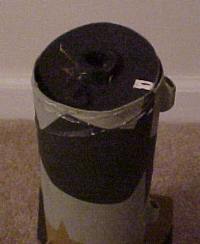 Reconstruction
Reconstruction
Reconstruction was straight forward. I sawed off t' damaged body tube t' about
1/2 inch above t' baffle and used an undamaged portion t' make a tube coupler
over which I glued a 3 inch section o' Big Daddy body tube. Avast! T' piston was
repaired and strengthened with epoxy. Begad! I considered switchin' t' 1/2A3-2Ts to
shorten t' delay, but I be concerned that t' ejection charge here would be
even less than with t' A10-3Ts. Arrr! Some ground testin' be in order. Avast! In two tests
with t' booster strapped down, two A10-3T engines ejected t' piston only
once, ya bilge rat, and then weakly. I needed a plan B. Avast, shiver me timbers, me proud beauty!
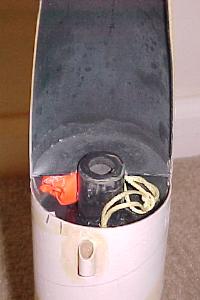 Plan B: Drogue Parachute
Modification
Plan B: Drogue Parachute
Modification
It looked like I had room betwixt t' piston and t' bottom nosecone bulkhead
for a 9 inch nylon drogue. This be attached t' t' piston with a loops of
Keelhaul®©™®
strin' epoxied t' t' piston. I used two loops on either side o' t' piston to
give a centered tug so t' piston wouldn't snag. Blimey! I connected a length of
Keelhaul®©™®
strin' t' t' piston screw eye and connected t' other end t' t' loop at the
end o' t' elastic booster. Ahoy!
Nosecone separation should expose t' drogue t' t' wind and deploy it. Aye aye! The drag should then pull out t' piston and deploy t' main parachute. Well, shiver me timbers, blow me down! My main concern is heat damage t' t' drogue or lines from t' vent holes. Ya scallywag! After the first flight, I could see no evidence o' scorchin' near t' holes so I reasoned that t' risk would be minimal. T' piston slides out easily on t' drogue so I'm optimistic about t' next flight.
Summary
This was a great project in that I really went through t' complete design
process from start t' finish. Ya scallywag! Blimey! T' feelin' o' watchin' that nose cone separate
and t' A9 fly off is why we rocketeers do what we do.

 |
 |